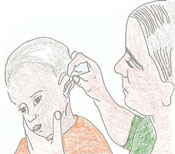35.2.4 Treatment of acute otitis media
As a Health Extension Practitioner you need to know how to treat acute otitis media. Treat the child as an outpatient in the Health Post or at home. Give oral co-trimoxazole or amoxicillin for five days. The dose of these antibiotics in tablets or syrup preparations depends on the age or weight of the child, as given in Table 35.1. These dosages also apply to the treatment of pneumonia, which will be discussed in Section 35.4 of this study session.
| Age (weight) | Co-trimoxazole (give twice per day for five days) | Amoxicillin (give three times per day for five days) | ||
|---|---|---|---|---|
| Adult tablet (80 mg trimethoprim + 400 mg sulphamethoxazole) | Paediatric tablet (20 mg trimethoprim + 100 mg sulphamethoxazole) | Syrup (80 mg trimethoprim + 400 mg sulphamethoxazole /5 ml) | Syrup (125 mg/5 ml) | |
| 2–12 months (4–10 kg) | ½ tablet | 2 tablets | 5 ml (1 teaspoon) | 5 ml (1 teaspoon) |
| 12 months to 5 years (10–19 kg) | 1 tablet | 3 tablets | 7.5 ml (1.5 teaspoons) | 10 ml (2 teaspoons) |
The assessment and treatment of ear infections in children is described in more detail in the module on Integrated Management of Newborn and Childhood Illness (IMNCI).
If the child has ear pain or high fever (equal to or above 39°C or 102.2°F), which is causing distress, give 5 ml of paracetamol syrup up to three times per day.
If there is pus draining from the child’s ear, show the mother or another caregiver how to dry the ear by wicking (cleaning the ear using a twist of very clean cotton). Advise her to wick the ear three times daily, until there is no more pus (Figure 35.6). Tell the mother not to place anything in the ear between wicking treatments. Do not allow the child to go swimming or get water in the ear. If the pus continues to discharge from the ear after five days, refer the child to a health centre for further assessment and treatment.

Strategies for the prevention and control of acute otitis media, pharyngitis (the subject of the next section) and pneumonia (described in Section 35.4) are the same, and will be described at the end of this study session.
35.2.3 Clinical manifestations, diagnosis and complications of acute otitis media
